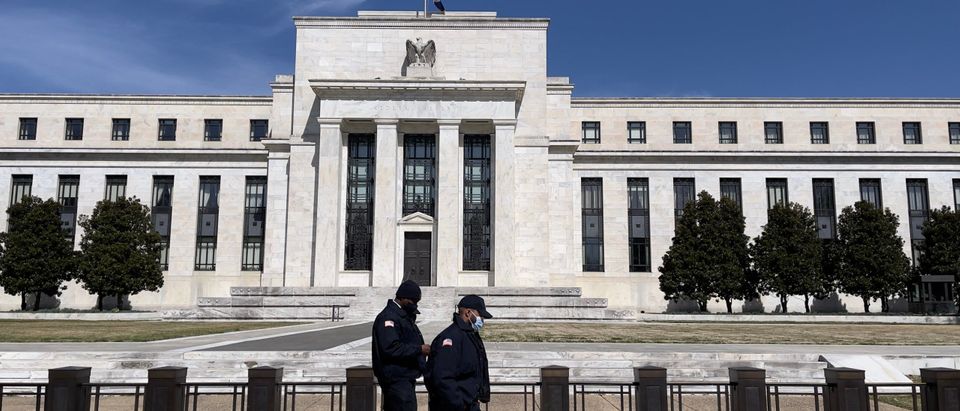Once again, the Federal Reserve blew it.
Fed economists, including then-Chairman Ben Bernanke, failed to anticipate the 2008 Great Recession and the housing market collapse that nearly wrecked the global economy.
Now, the Fed, including Chairman Jerome Powell, failed to anticipate today’s rampant inflation, having repeatedly dismissed it months ago as merely “transitory.”
You have to wonder whether any of the Fed’s economists ever heard of, or read, the late Nobel laureate in economics Milton Friedman, who famously wrote that “inflation is always and everywhere a monetary phenomenon.”
Econ 101 defines inflation as “too much money chasing too few goods.” Let’s deconstruct those words.
The “too much money” today comes from more than a decade of profligate monetary and fiscal policies. Following the Great Recession, the Fed began printing money through successive rounds of “quantitative easing,” in which it purchased mortgage-backed securities (to bolster the housing market) and then other assets such as corporate bonds.
By February 2020, the Fed’s balance sheet had swollen to $4.17 trillion. In an effort to prevent a COVID recession, the Fed has now grown its balance sheet to nearly $8.7 trillion as of last month.
The profligate fiscal policy resulted from bipartisan-sponsored deficit spending that has now grown the U.S. national debt to nearly $29 trillion.
The Fed’s ultra low interest rate policy has seriously damaged the ability of financial markets (now casinos all but in name) to achieve real asset-price discovery. As a result, we see unsustainable bubble prices in equities, bonds, cryptocurrencies, and housing as investors frantically seek higher yields here and abroad.
At some future point, the Fed will have to unwind its balance sheet, and doing so given today’s rising inflation will entail raising interest rates. When interest rates rise, servicing the national debt costs more and constrains other priorities in the federal government’s annual budget.
Those asset bubbles, sustained by low interest, easy money rates, will unwind in their own manner by bursting. They always do.
“Too few goods” can definitely be explained, partly, by supply-chain bottlenecks after nearly two years of dealing with the coronavirus. American consumers are cash-rich today and eager to spend, but we also see major delays in the delivery of goods – delays associated with a shortage of truckers who have exited the labor force for several reasons, including overly generous income maintenance payments during the pandemic.
At some point, the money supply will adjust, deficits will be curbed and supply chains will normalize. In that sense, today’s inflation will be “transitory,” just as every other instance of inflationary damage ended (including Weimar Germany’s hyperinflation).
At issue is how much lasting damage results from these sustained and flawed economic policies.
The Fed has two principal statutory goals: maintaining price stability and full employment. In recent years, the Fed has adopted a third goal: targeting an annual two percent inflation rate.
Before today’s inflationary surge, that realized inflation rate was below 2 percent. Now the Fed suggests maintaining an “average” 2 percent inflation rate over several years, thereby accommodating today’s 6.2 percent inflation rate for, perhaps, a bit longer in order to reach that 2 percent multiyear average.
In the meantime, American households are getting clobbered. Consumers care about the cost of gas, food and rents today – not what average prices might be over, say, a five-year period.
Here’s a real world example: I have a storage space for overflow household items. The storage company notified me last week that next month, the monthly fee was increasing by 7.5 percent. A storage space just sits there. It doesn’t move and doesn’t depend on supply chains. It’s also not terribly labor intensive and incurs costs mostly for rent, lighting, security, advertising and cleaning. It is highly unlikely that this 7.5 percent increase will ever be reversed.
How many other items in the U.S. economy are experiencing similar permanent cost increases?
Globalization is slowing, and cheap Chinese goods may not be so cheap in the future as Chinese labor costs rise.
Now we read that progressive Democrats want the Fed to expand its mission, particularly as it relates to the banking sector, to include metrics tracking “Diversity, Equity, and Inclusion” as well as climate change.
The Fed should “stick to its knitting” and focus on its two core functions. In doing so, its economists should look up from their mathematical models, examine what’s happening in Americans’ household economies, and spend more time studying Milton Friedman.
If the Fed goes “woke,” we’ll all go broke.
Charles Kolb served as Deputy Assistant to the President for Domestic Policy from 1990-1992 in the George H.W. Bush White House


